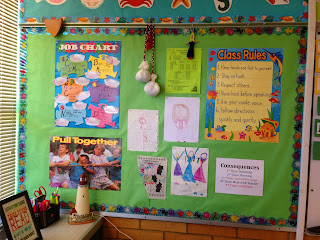That meant another trip to Utah to help her set up her classroom for the second time. I've now helped set up three different classrooms and I began to see certain parallels between this process and the process of writing.
First, in this day and age, much as you may like to write by hand, in the end you can't avoid the technical. Manuscripts must be typed in the end and most submissions are now done online or by email. School is no different. Even though these are only First Graders, this was a Title 1 school and so one whole wall was devoted to computers.
You can't see it from here, but that's a Math bulletin board above the computers. While writers tend toward right brain activities, we can't neglect the business side of our profession if we want to be successful. We have to count sales, deal with sales tax, etc.
Happily, though, our main concern is with words. And words are most important to First Graders as they are trying to master reading and writing. This bulletin board or Word Wall at the back reminded me of my need to avoid repetition of certain words and, instead, search for new ways to express common ideas.
But we don't ask these young kids to read without also encouraging them to take their first real steps in writing. My daughter's classroom has a theme of "Sailing Toward Knowledge," and like these inexperienced first graders, we can sometimes feel "Under the Sea" when it comes to taking our pencils or keyboards in hand and pounding out that first draft.
I might point out, as well, the names of the months above the entire back bulletin board--a reminder that we must write day in and day out, week after week, and month after month if we expect to get better at our craft.
Next is our continual need for resources and research material. She has a whole side of her room devoted to math manipulatives, books, and other educational tools. Likewise, we writers need ready access to the kinds of resources that will enhance our finished product...beginning with a good dictionary and grammar book.
At the same time, both writers and teachers need to establish certain boundaries or rules for themselves and those with whom they are engaged. A teacher needs to outline class rules and consequences for misbehavior, as well as inspire both the children and herself/himself. A writer needs to outline his/her own rules (such as no social media until your writing is done for the day) both for self and loved ones who may share the same roof. After all, though both occupations can be time consuming, teaching or writing is not, in the end, the sole purpose of our existence.
I interview other writers a lot for my own blog and I invariably ask about their "writing space." I'm always intrigued to know what works for other writers and what it may reveal about them. For me, I need some kind of view, something that sends my mind beyond myself. In the same way, First Grade teachers need to set up a happy, colorful environment that will pull in these young minds.
Neither of these women is my daughter. The one on the right is her full-time aide, though...another benefit of a Title 1 school. Sometimes, as a writer, I wish I had a full-time aide and that's where critique groups and writing groups come in. They can help us see the weak links in our work and inspire us to forge ahead. We like to think of our profession as a solitary kind of occupation, but I think we all relish the opportunity we get at writers conferences and retreats to mingle with other like-minded individuals. In the same way, teachers now work as teams more often than not. And my daughter has a terrific team.
In the end, though, it's you facing a blank screen and making a decision about what to put on it. You've got all the letters, numbers, words, and ideas running around in your head. But which ones will you use and when and how?
That's where a clean, orderly work station comes in. Granted, every few months or so I find I have to reorganize and clear away the clutter, but I always write better (and I'm sure teachers always teach better) when the "house" is in order.
When all else fails, turn to a good book. You can't write well if you don't read a lot. And there are times (like after you've just finished one manuscript) when you need to relax and hibernate a bit. Do it with a good book or two. Teachers do the same thing. If a lesson has failed that day, First Grade teachers can always count on an entertaining read to pull the kids' attention back and make everyone (especially the teacher) feel better. "Piggie Pie" will do it every time!
Finally, one thing continues to provide the necessary fuel, whether I'm writing or helping to set up a classroom: chocolate. Let's just say I ate a lot of M&Ms this past week. :D











No comments:
Post a Comment